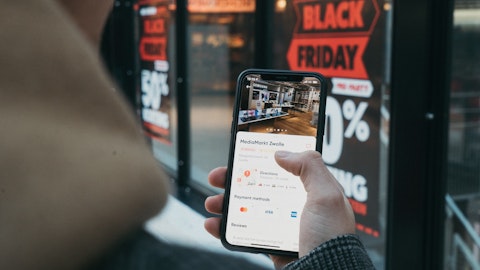Andrew Bialecki: That’s great. I’ll add one thing on top of what Amanda just shared. So our product teams are obviously still very focused on delivering a great out-of-the-box experience, regardless of the stage of the business, whether you’re just starting out or you’re a large enterprise. And within — we talked about mid-market. Within this kind of SMB, more established businesses, we still think we have a long way to go in terms of market share. We talked about our relationship with Shopify and Shopify Plus and growing there. There’s also — we continue to invest in existing partnerships and platforms. There’s other platforms in the retail and e-commerce space that we’re doing more work with and then also internationally. We think there’s a lot of — as Amanda mentioned, we’re relatively early in growing internationally. We think there’s a lot of SMBs, large quantity of customers that should be running on Klaviyo.
Operator: Next, we’ll go to Tyler Radke at Citi.
Tyler Radke: Yes. Thanks for taking the question. Similar question on go-to-market. I guess, two-parter here. Number one, it looked like sales and marketing ticked down a bit sequentially. Could you just talk about kind of the changes in spend that you’re seeing there? And then where are you focusing the go-to-market investments here? Is it — you talked about some international opportunities, especially in France. Are there certain industries that you’re leaning into more? If you could just talk about where you’re targeting those investments? Thank you.
Andrew Bialecki: Great. I’ll talk a little bit about like our strategy, and then Amanda can talk to the trend in sales and marketing spend. So I mentioned that on the sales side, we’ve been increasing sales capacity very intentionally to focus on three core areas. The first being mid-market, where we’re seeing strong growth. The second is internationally, where we think again a big opportunity. And then the third is what we call our customer growth team that works with existing Klaviyo customers to help them adopt the full Klaviyo platform. So that’s going well, and we think we’re well positioned there. On the marketing side, we’re in some of these newer areas, we mentioned mid-market, we mentioned international. We’re investing in brand and folks knowing who we are and also creating moments for folks to really attach to us.
You saw our Klaviyo ad launch a few months ago. We’re big believers in customer events. Our Klaviyo London Conference brings together both existing customers to use more Klaviyo as well as net new customers to meet those — meet existing customers and learn from their experience. So we also — we really like what we’re seeing from those investments as well. Finally, I’ll mention that on the marketing side, we’re doing a lot of educating the market and even some existing customers about all of our products, especially our newer products. Just to give you a little example, I talk to a lot of customers who are advanced e-mail users of ours. But they’re still learning about what SMS can bring to their business or what other channels or CDP can bring.
And so we think there’s a lot of upside there. So we’re doing all of that, still very much focused on retail and e-commerce, and with strong commitments to good unit economics and experimenting and staying disciplined.
Amanda Whalen: Thanks. And then regarding the sequential step down in sales and marketing that you asked about, that has to do with the seasonality of investments. So it’s primarily marketing and marketing timing, because we have a lot of marketing programs that are linked to the holiday shopping season. As Andrew said, we’re continuing to invest in sales capacity. We’ll be ramping up marketing programs, particularly through the second half of the year. And you can see the timing of that reflected in some of the comments that we had in our prepared remarks talking about how we expect operating margins to unfold over the course of the year.
Operator: We’ll take our next question from DJ Hynes at Canaccord.
DJ Hynes: Hey guys. Congrats on the nice quarter. AB, maybe we can go back to that large win with the women’s online fashion brand. Curious what the RFP looked like there. Who else was involved? How long was the sales cycle? Kind of what ultimately tipped the decision in your favor would be helpful color.
Andrew Bialecki: Sure. So in the mid-market and enterprise, we still — it’s a lot of older tech, and that obviously doesn’t include the back-end customer database that we have, which limits the amount of personalization and the kinds of experiences you can build across e-mail, SMS and other channels. So legacy tech as well as just like point solutions, things that just help with one marketing channel all the time. In that particular case, the actual customer had been on Klaviyo a few years ago and had thought they’d outgrown us, but then they’ve since grown a lot. We’ve scaled up our systems and they came back. And they came back for a lot of the reasons that I hear from a lot of our customers. Our integration tightly with their back-end retail and e-commerce systems as well as integrations into their more consumer-facing with their website and things that sit outside of marketing, so those integrations, combined with the ease of use, the ability to get a lot of things done, I think that’s the access to data and being able to use that to personalize plus where we’re going.
I talk to a lot of our larger customers. They’re really excited about not just our customer database and consolidating channels, but also what we’re going to be able to do with artificial intelligence and the ability to take the data you have and plug it into every aspect of the consumer experience. A lot of our larger mid-market and enterprise brands, they still feel like they haven’t been able to fully stitch that together. They don’t have a single source of truth for consumer data. Not all of the front-office pieces, the software that interfaces with the consumer, they don’t all talk to each other. I think with Klaviyo, we’ve really got a shot at being that company. And that’s what we talk about is that we’re going to move quickly to build products that both addresses what they want to do with data and marketing today but also build out this broader CRM for consumer businesses.
So I think both where we are and where we’re going, that’s what makes it interesting.
Operator: We’ll go next to Nick Altmann at Scotiabank.
Nick Altmann: Awesome. Thanks guys. I wanted to build on Raimo’s question on the international side. Andrew, just given you guys are coming off the EMEA event and you guys have rolled out a plethora of features geared at those international customers. I was wondering if you could just maybe talk about how those conversations with international customers are different from customers in the U.S. just in terms of buying propensity, where they’re at with their martech journeys, interest in various channels, willingness to consolidate, et cetera. Just any other color you can provide and how those conversations differ with international versus U.S. customers would be interesting. Thanks.
Andrew Bialecki: Yes, sure. Yes. It was a great event, and it’s always great to get hands on with customers and hear from them directly about what really matters. So first, the sophistication level, both in Europe and in Asia, is excellent. I mean, these are businesses that are — they’re really driven. They know what they want to do. They know the data they should have access to, and they’ve got a lot of ideas on how to put it to work. The challenge for a lot of — both in Europe and Asia, it’s really about complexity. And because we’re reducing that, that’s really — I mean, that’s the winning value prop. I mean, to give you a quick story, we launched Klaviyo portfolio, a set of tools to manage multiple Klaviyo accounts, multiple regions, multiple brands, all in one place.
When we were at the event, I asked a panel of customers. I said, hey, how many of you log in to Klaviyo at least once — multiple accounts at least once a week? Almost everybody raised their hand. And I said, how many of you log into at least 10 different Klaviyo accounts every week? And not many hands went down. Still, the majority of folks were working either across brands or they had different stores, different websites for every single region in Europe. So we’re launching features like that to help reduce the complexity. We did Klaviyo portfolio. We spent the last 12 months really building out all the plumbing so we could internationalize our product, both the actual like software itself as well as all of our technical documentation, all of our guides and tutorials.
We just launched that with France. The team put in a huge effort to do that, but set it up in such a way that we’re going to be able to quickly move from English to French to many other languages, which will help us address more of the international — our international customers and who should be future customers. So you kind of add up all those pieces as well as we’ve got hundreds of partners over in Europe that are very sophisticated, very focused on a lot of great ideas, that plus our platform partners plus a growing number of customers, that’s creating a flywheel that’s allowing us to then overlay additional sales headcount, run marketing campaigns and grow internationally efficiently.



